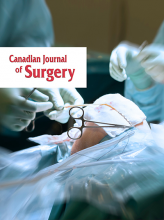An elderly woman in a vegetative state from previous head trauma was transferred from her nursing home to the emergency department for evaluation of a 5-day history of abdominal distention and fever. On examination, she was febrile to 40°C and had an edematous abdominal wall with mild left-sided erythema. One week before presentation, her feeding gastrostomy tube was replaced following temporary dislodgment. An abdominal radiograph showed diffuse subcutaneous emphysema over her torso (Fig. 1). A CT scan was consistent with necrotizing fasciitis: destruction of the subcutaneous and fascial tissues and abscess formation (Fig. 2). Contrast injected via her gastrostomy tube extravasated into her abdominal wall. The patient underwent emergent operative débridement of her abdominal wall down to the posterior fascia. Multiple subsequent débridements were carried out at the bedside and in the operating room. She was discharged to a chronic care facility 4 weeks after presentation with a skin graft covering her abdominal wall defect.
Plain radiograph of the abdomen showing massive subcutaneous emphysema.
An abdominal CT scan reveals extensive soft tissue destruction and abscess formation. There is no intraperitoneal extension of this process.
Necrotizing fasciitis of the abdominal wall is a devastating diagnosis that carries a high mortality if not promptly diagnosed and treated. Signs and symptoms of necrotizing fasciitis include high fever, localized pain, cellulitis over the affected area, edematous soft tissues and subcutaneous emphysema.1 However, these clinical features can be quite subtle, and the diagnosis requires a high index of suspicion. Plain abdominal radiographs show subcutaneous emphysema and are diagnostic in the appropriate clinical setting. CT scans are usually not required but can be useful to rule out a contiguous intraabdominal process. The only effective treatment for this disease is immediate operative débridement of all nonviable tissues. Multiple “second look” operations are often needed to further débride and assess tissue viability. These infections are usually polymicrobial, and the role of antibiotics is purely adjunctive.2 Operative treatment of this disease usually leaves a gaping abdominal wall defect, and creative plastic surgical procedures are often required for abdominal wall reconstruction.
Footnotes
Submissions to the Surgical Images, soft tissue section, should be sent to the section editors: Dr. David P. Girvan, Victoria Hospital Corporation, PO Box 5375, Station B, London ON N6A 5A5 or Dr. Nis Schmidt, Department of Surgery, St. Paul’s Hospital, 1081 Burrard St., Vancouver BC V6Z 1Y6.
Competing interests: None declared.
- Accepted March 29, 2004.











